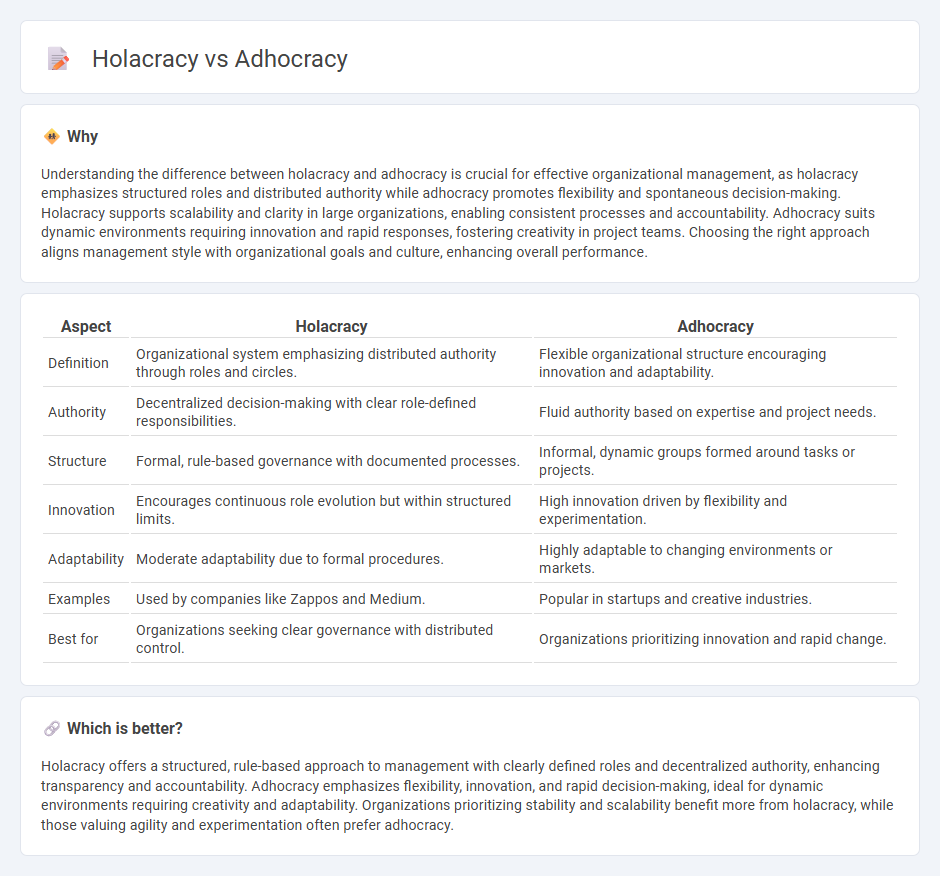
Holacracy emphasizes decentralized authority through self-organizing teams governed by clear roles and distributed decision-making, fostering agility and accountability within organizations. Adhocracy champions a flexible, innovation-driven approach, encouraging spontaneity and decentralized problem-solving to swiftly respond to dynamic environments. Explore the distinct advantages and implementation strategies of holacracy and adhocracy to optimize your management approach.
Why it is important
Understanding the difference between holacracy and adhocracy is crucial for effective organizational management, as holacracy emphasizes structured roles and distributed authority while adhocracy promotes flexibility and spontaneous decision-making. Holacracy supports scalability and clarity in large organizations, enabling consistent processes and accountability. Adhocracy suits dynamic environments requiring innovation and rapid responses, fostering creativity in project teams. Choosing the right approach aligns management style with organizational goals and culture, enhancing overall performance.
Comparison Table
| Aspect | Holacracy | Adhocracy |
|---|---|---|
| Definition | Organizational system emphasizing distributed authority through roles and circles. | Flexible organizational structure encouraging innovation and adaptability. |
| Authority | Decentralized decision-making with clear role-defined responsibilities. | Fluid authority based on expertise and project needs. |
| Structure | Formal, rule-based governance with documented processes. | Informal, dynamic groups formed around tasks or projects. |
| Innovation | Encourages continuous role evolution but within structured limits. | High innovation driven by flexibility and experimentation. |
| Adaptability | Moderate adaptability due to formal procedures. | Highly adaptable to changing environments or markets. |
| Examples | Used by companies like Zappos and Medium. | Popular in startups and creative industries. |
| Best for | Organizations seeking clear governance with distributed control. | Organizations prioritizing innovation and rapid change. |
Which is better?
Holacracy offers a structured, rule-based approach to management with clearly defined roles and decentralized authority, enhancing transparency and accountability. Adhocracy emphasizes flexibility, innovation, and rapid decision-making, ideal for dynamic environments requiring creativity and adaptability. Organizations prioritizing stability and scalability benefit more from holacracy, while those valuing agility and experimentation often prefer adhocracy.
Connection
Holacracy and adhocracy both emphasize decentralized decision-making and flexibility within organizational management, promoting self-organizing teams that adapt quickly to change. Holacracy provides a structured framework with clearly defined roles and governance processes, while adhocracy relies on informal, dynamic collaboration to foster innovation and responsiveness. These approaches connect through their shared commitment to empowering employees and minimizing hierarchical constraints to enhance organizational agility.
Key Terms
Decentralization
Adhocracy emphasizes flexible, decentralized decision-making where teams dynamically form to address specific challenges, fostering innovation and rapid problem-solving. Holacracy implements structured decentralization through clearly defined roles, distributed authority, and formal governance processes to maintain organizational order and accountability. Explore the distinct approaches to decentralization and how they impact organizational agility by learning more about adhocracy and holacracy.
Flexibility
Adhocracy emphasizes flexibility through dynamic, project-based teams that adapt quickly to changing environments without rigid structures. Holacracy incorporates flexibility within a defined framework using roles and circles, enabling decentralized decision-making while maintaining organizational clarity. Explore more about how these models enhance agility and innovation in modern organizations.
Self-management
Adhocracy emphasizes flexible, project-based teams empowered to make decisions rapidly without rigid hierarchies, fostering innovation through decentralized self-management. Holacracy formalizes self-management with structured roles, distributed authority, and transparent governance processes to balance autonomy and accountability within the organization. Explore how these models optimize self-management strategies to enhance agility and employee engagement.
Source and External Links
Adhocracy | Social Science & Organizational Structure - Britannica - Adhocracy is an organizational design characterized by high flexibility, loose coupling, and adaptability to frequent change, often allowing decision-making authority to rest with skilled technical experts in fluid, problem-solving teams rather than a strict hierarchy.
What is adhocracy culture: Definition, key characteristics and ... - Adhocracy culture promotes creativity, innovation, and adaptability through decentralized authority and encourages experimentation and risk-taking within an open communication environment.
Adhocracy - Wikipedia - Adhocracy is a flexible, adaptable form of organization with informal structure and multidisciplinary teams, designed to promote fast problem-solving and innovation in contrast to traditional bureaucracies.
 dowidth.com
dowidth.com